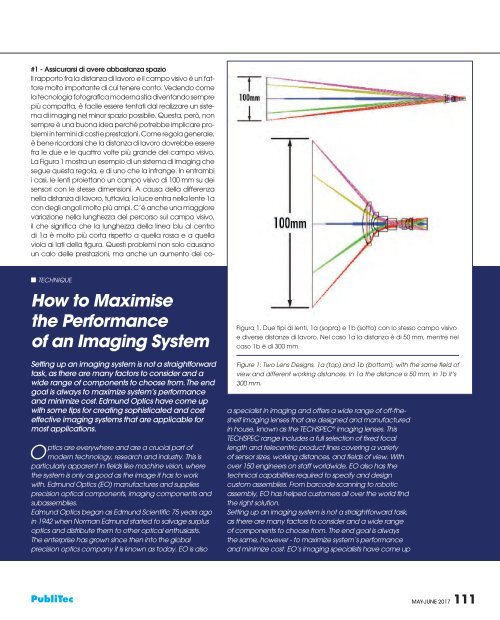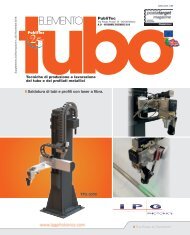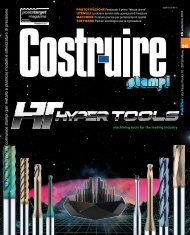AsseMec120_MAGGIU_2017
Create successful ePaper yourself
Turn your PDF publications into a flip-book with our unique Google optimized e-Paper software.
#1 - Assicurarsi di avere abbastanza spazio<br />
Il rapporto fra la distanza di lavoro e il campo visivo è un fattore<br />
molto importante di cui tenere conto. Vedendo come<br />
la tecnologia fotografica moderna stia diventando sempre<br />
più compatta, è facile essere tentati dal realizzare un sistema<br />
di imaging nel minor spazio possibile. Questa, però, non<br />
sempre è una buona idea perché potrebbe implicare problemi<br />
in termini di costi e prestazioni. Come regola generale,<br />
è bene ricordarsi che la distanza di lavoro dovrebbe essere<br />
fra le due e le quattro volte più grande del campo visivo.<br />
La Figura 1 mostra un esempio di un sistema di imaging che<br />
segue questa regola, e di uno che la infrange. In entrambi<br />
i casi, le lenti proiettano un campo visivo di 100 mm su dei<br />
sensori con le stesse dimensioni. A causa della differenza<br />
nella distanza di lavoro, tuttavia, la luce entra nella lente 1a<br />
con degli angoli molto più ampi. C’è anche una maggiore<br />
variazione nella lunghezza del percorso sul campo visivo,<br />
il che significa che la lunghezza della linea blu al centro<br />
di 1a è molto più corta rispetto a quella rossa e a quella<br />
viola ai lati della figura. Questi problemi non solo causano<br />
un calo delle prestazioni, ma anche un aumento dei co-<br />
n TECHNIQUE<br />
How to Maximise<br />
the Performance<br />
of an Imaging System<br />
Setting up an imaging system is not a straightforward<br />
task, as there are many factors to consider and a<br />
wide range of components to choose from. The end<br />
goal is always to maximize system’s performance<br />
and minimize cost. Edmund Optics have come up<br />
with some tips for creating sophisticated and cost<br />
effective imaging systems that are applicable for<br />
most applications.<br />
Optics are everywhere and are a crucial part of<br />
modern technology, research and industry. This is<br />
particularly apparent in fields like machine vision, where<br />
the system is only as good as the image it has to work<br />
with. Edmund Optics (EO) manufactures and supplies<br />
precision optical components, imaging components and<br />
subassemblies.<br />
Edmund Optics began as Edmund Scientific 75 years ago<br />
in 1942 when Norman Edmund started to salvage surplus<br />
optics and distribute them to other optical enthusiasts.<br />
The enterprise has grown since then into the global<br />
precision optics company it is known as today. EO is also<br />
Figura 1. Due tipi di lenti, 1a (sopra) e 1b (sotto) con lo stesso campo visivo<br />
e diverse distanze di lavoro. Nel caso 1a la distanza è di 50 mm, mentre nel<br />
caso 1b è di 300 mm.<br />
Figure 1: Two Lens Designs, 1a (top) and 1b (bottom), with the same field of<br />
view and different working distances. In 1a the distance is 50 mm, in 1b it’s<br />
300 mm.<br />
a specialist in imaging and offers a wide range of off-theshelf<br />
imaging lenses that are designed and manufactured<br />
in house, known as the TECHSPEC ® imaging lenses. This<br />
TECHSPEC range includes a full selection of fixed focal<br />
length and telecentric product lines covering a variety<br />
of sensor sizes, working distances, and fields of view. With<br />
over 150 engineers on staff worldwide, EO also has the<br />
technical capabilities required to specify and design<br />
custom assemblies. From barcode scanning to robotic<br />
assembly, EO has helped customers all over the world find<br />
the right solution.<br />
Setting up an imaging system is not a straightforward task,<br />
as there are many factors to consider and a wide range<br />
of components to choose from. The end goal is always<br />
the same, however - to maximize system’s performance<br />
and minimize cost. EO’s imaging specialists have come up<br />
PubliTec MAY-JUNE <strong>2017</strong> 111





